Winter Solstice + First Quarter: Holly, ivy
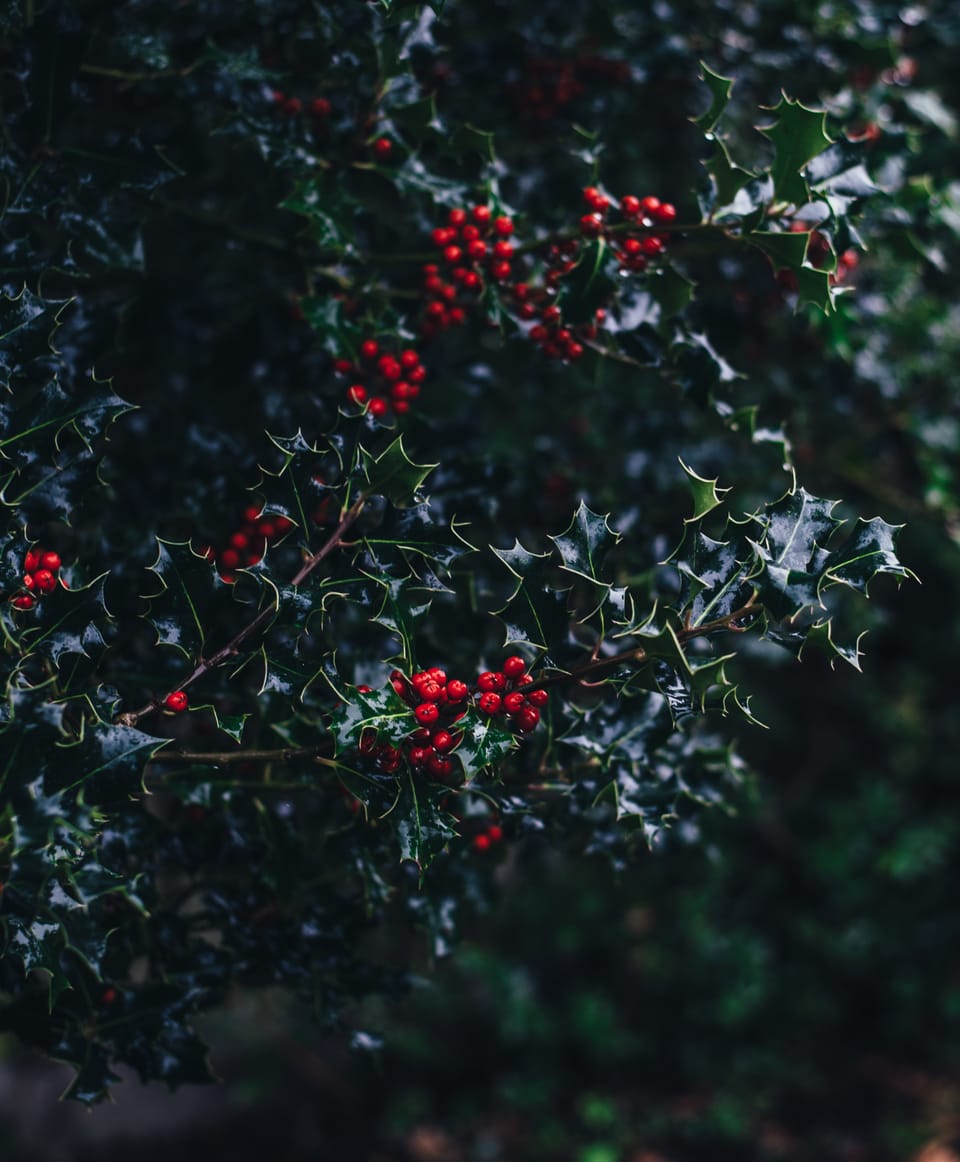
Hello. It's Friday, and I've come back to another post for what I call Jól, the winter solstice. Last year I wrote of that day in the context of satanism and anti-authoritarian misrule, but as the Wheel has spun around to this season again in a different phase of the Moon, I am turning my thoughts this Jól to matters of green. What I'm about to write here presumes that someone reading has already read last year's post and others concerning the Wheel of the Year, so if you are newer here, here is what's come before.
What follows is a matter of tree lore, the trees in question being holly and ivy.
If those seem odd to consider as trees, especially compared to other solstitial decorations like pine and fellow conifers, now is as good a time as any to note that my typical ritual point of reference for a tree, so-called[1], is partly those plants which are found in the ogham, that is the pre-Latinized Irish alphabet. As I've touched on elsewhere, ogham letters are traditionally associated with various trees; and though it's hard to say whether this is because they look so twiggy or whether causation worked the other way around, the applicable literature and folklore are part of the chain of evidence that Iron Age Celts gave trees a particularly important role within their animist cosmology. I don't engage with Irish or other Gaelic material as much as with that of my ancestral Cymru, but there have been millennia of cultural exchange between the two groups, both through friendly trade and violent sea raids, and the ogham typifies this complex relationship, with ogham in use across portions of the Cymric coastline between the late Roman period and the early medieval years. What those Cymric Britons thought of the tree-letters they'd adopted, no one knows, especially since they were more Christianized by then — but less than popular history likes to claim, and in any case they were still syncretic animists.
All of which is to say: holly and ivy are both represented in the lore of ogham, and so my tree work must intersect with these two entities. Now is the best time of year for me to explore them.
Deep green winter magic
I need to give some prologue regarding the value of all winter greens. Within a European context the tradition precedes Christianity, though in terms of historical documentation this is not about cultures outside the scope of the Roman Empire — rather, hanging evergreens indoors was practiced by Romans, a custom in their pagan era that belonged to the New Year, as I'll write further about next week. This green-hanging practice was either adopted by cultures the Romans colonized, or kept in parallel by those cultures as their own midwinter or near-midwinter rites; if we never learn which way things went, the most important part is that the chosen greens varied by bioregion.
The Roman way was laurel boughs, which despite not being conifers are evergreens in their own right. Elsewhere, there reigned the pine, the spruce, the fir, the juniper. Traditions have particularly developed around plants that are not only evergreen but also fruit in winter, holly and ivy each being a prime example although their berries are too poisonous for humans to eat. Even without sustaining us, holly and ivy sustain songbirds through the darkest days, and they show the land is still living.
To me this is the mystery of winter greens. They often "only" bring us aroma or visual appeal, a psychological rather than physical survival mechanism — but we need that knowledge of the cold winter world's continuing life cycles. Likewise, we think of winter as a dead season most of the time, but vital processes are everywhere throughout, even if they hide from human eyes.
In this way, I understand why people — including those self-describing as pagans — celebrate the winter solstice as "the return of the light," but I think this mindset can all too easily lead to the runaway light-seeking, heat-seeking behavior that fails to grasp why eternal summer would be an evil. I celebrate the winter solstice as the depth of darkness itself, a strange yet necessary time.
Yuletide binaries
In turn, while some people who observe the Holly King vs. Oak King dichotomy treat the winter solstice as a night of battle where the Holly King is thrown down, I see no seasonal battle at this time. The solstice is a static moment, persistent, the day's shortness barely perceptible versus surrounding days. The Holly King's reign is rather at its height, and though his power must now dwindle from here, he will not grow truly vulnerable until the coming equinox.
But if such tension is absent now, there are still other tensions at play between other polarities, not of time-space but rather of human politics. As I wrote about in last year's Jól post, this holiday is one that serves as a common entry point for exploring Christian/animist syncretism even if the "true pagan story" of Christmas is not what's represented in typical social media memes. The winter solstice and solstice-adjacent days have been typified by debate around their fundamentally Christian vs. pagan nature for as long as Christmas has ever been observed in this season.
One 18th-19th century Christmas carol that exemplifies this debate is "The Holly and the Ivy." In its decidedly Christian lyrics, the holly plant is used as a means of describing Jesus' traits, so though it begins like so:
The holly and the ivy,
When they are both full grown,
Of all the trees that are in the wood,
The holly bears the crown.
(Refrain) The rising of the sun
And the running of the deer,
The playing of the merry organ,
Sweet singing in the choir.
It continues with verses like:
The holly bears a berry
As red as any blood,
And Mary bore sweet Jesus Christ
For to do us sinners good.
There are many variations on exact phrasing[2] and there is also more than one melody, major key versus minor; but the song is Christian. And curiously, while the ivy in the song is considered to be analogous to the Virgin Mary, these lyrics contain no discussion of ivy whatosever beyond the first line.
Predictable patriarchy, maybe, to not only give "the crown" to holly but also to ignore ivy altogether. But why is ivy present at all? The answer lies in a Renaissance-era (and possibly older) version of the song named "The Contest of the Ivy and the Holly," which runs as follows:
Holly stands in the hall, fair to behold:
Ivy stands without the door, she is full sore a cold.
(Refrain) Nay, ivy, nay, it shall not be I wis;
Let holly have the mastery, as the manner is.
Holly and his merry men, they dance and they sing,
Ivy and her maidens, they weep and they wring.
(Refrain)
Ivy hath chapped fingers, she caught them from the cold,
So might they all have, aye, that with ivy hold.
(Refrain)
Holly hath berries red as any rose,
The forester, the hunter, keep them from the does.
(Refrain)
Ivy hath berries black as any sloe;
There come the owl and eat him as she go.
(Refrain)
Holly hath birds a fair full flock,
The nightingale, the popinjay, the gentle laverock.
(Refrain)
Good ivy, what birds hast thou?
None but the owlet that cries how, how.
(Refrain)
Holly here is praised as a cheery plant worth bringing indoors. Though just as important to birds in winter, ivy is maligned as an outdoor-only plant — presumably owing to its rapidly invasive qualities and tendency to grow on exterior walls. And unfortunately, the plants are also gendered. Masculine holly has the mastery, bears the crown, as the ways things "ought" to be, while feminine ivy comes across as frigid in all the worst senses of the word.
Is this a matter of ancient misogyny in pagan Britain rearing its head, or is it a matter of Christian and proto-capitalist misogynies imposing themselves upon women in the Renaissance to a markedly extreme degree? I don't know. But while I do enjoy all of these songs for their melodies or as folk artifacts, I certainly think that ivy deserves better. In my own rites, there is only a Holly King to worship in this season, but if I were to ever devote myself to a goddess as well as a god, perhaps she would have to be the Ivy Queen.
And if nothing else, here are my odes to the plants themselves, each equal as earth-spirits.
Holly
Holly, I know you best as Ilex aquifolium, the European holly whose image emblazons mass-made Yuletide merchandise — and less cynically speaking, whose form my deep ancestors would have known.
You grow slowly and live long. Often you are not allowed your full height, but guarded from pruning shears you can become a tree by any measure, as tall as a house. In the forest you belong to the same ecosystem as the oak. Holly, oak, intertwined. Shade is no trouble for you; you thrive in darkness. Your wood makes good fires and furniture alike.
But while something in my memory calls for you, longing to touch your sacred spikes, I also know you as out of place on the land where I walk, where other Ilex belongs instead.
There is Ilex opaca, American holly, its leaves still spiked and evergreen, but rounder; I wish I knew your Algonquian name, proper to this place. I have also rarely glimpsed you — around here, I do not see holly with leaves in winter at all. The marshlands in this river valley are packed with Ilex verticillata, the winterberry or fever bush, which explodes in red clusters in this season but also drops its leaves, deciduous. You, winterberry, are poisonous like your cousins, but your human custodians know how to prepare your medicine.
I would like to plant a holly outside this house, and I think winterberry should perhaps be the choice. I know and love it, and though the same could be said for the European kind, as in so many other matters the European is invasive on this continent. Moreso on the West Coast than over here, but I think it would be selfish to plant that holly just because I wanted something from my familial homeland.
On Jóls to come, I wish to weave a crown of holly berries for my owner, my lord, my king.
The holly bears a berry
As red as any blood;
The Holly King brings darkness
To do sweet sinners good.
Ivy
For all the hollies in the world, there are many ivies too. Ancestrally I am called to Hedera helix, European ivy, but I'm familiar with relatives from across Eurasia. All of them are invaders to this continent, a creeping pest much like kudzu. However, lovely ivy, you are not such a pest where your vines belong.
In your true ecosystem, you have creatures and diseases that can keep you under control, and so you do not harm the trees you climb upon. You provide special habitats where you twine, and as ground cover you provide excellent soil-fixing, preventing erosion. Contrary to the contest song that maligns you, in folklore you are a sign of love, of two beings growing together.
You are also sacred to Dionysos, for all vines are his, not only the grape. In this — as I map Dionysos to the Holly King — you are equal to holly in dark, ecstatic rites.
Are you a tree?
You are woody along your stem. Not all vines can boast the same. And as you cover other trees, with time they die — whether on their own, or by your own invasive doing — and you claim their silhouettes. A mirror, a reflector, lunar in power.
The mysteries of ivy do not seem comfortable or plain to me, but they are held in the darkest, queerest shadows. A plant of the fey. A plant of winter lessons: you are not showy, but you endure.
Hail, then, to the queen vine of the dark.
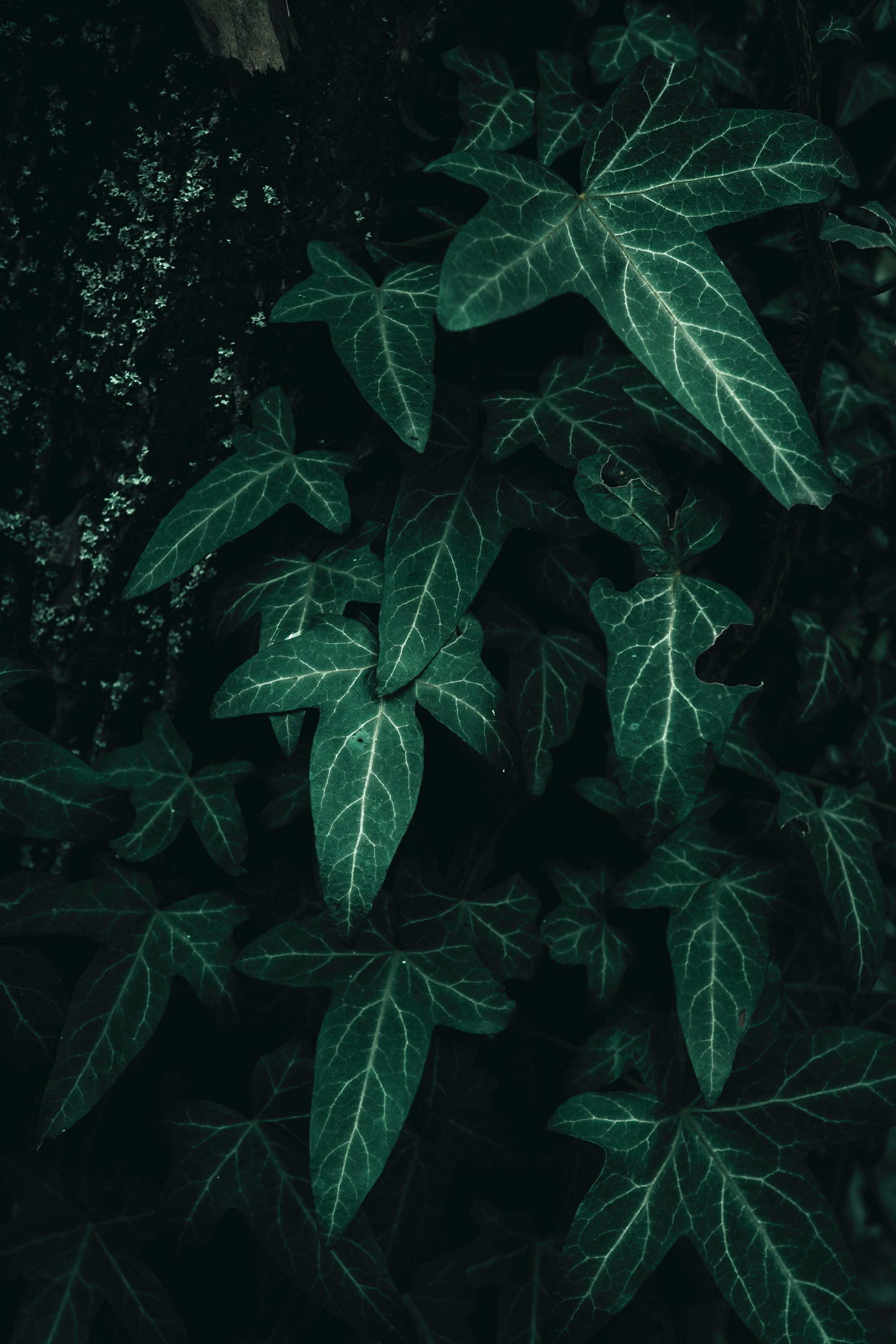
[1] Botanically, there is also not a fixed taxonomic clade of trees, which may be found across the plant kingdom in various families, where woody stems/trunks and other tree-like features have been a matter of convergent evolution.
[2] The above is from Cecil Sharp, a politically dubious person but of critical significance to the ethnomusicology of Britain, especially England, in the context of folk traditions as animist preservation tools.
Thank you for reading, and may your Yuletide be merry. Next week as mentioned I will be writing a short history of New Year's as a pagan/animist observance, and the week afterward will be a paid post on my growing interest in mortuary science.
One last note: I have met with great financial fortune quite unexpectedly for reasons that don't bear putting here today, but it is safe for me to say that the burdens I had originally hoped to relieve by starting this newsletter are now substantially altered for the better. I may explain more later, and in any case now when I gently nudge about paid subscriptions it will usually not be to recover my publishing costs or make ends meet — rather, I've found myself in the position to keep this project going more for the sake of sharing what's in my head and heart and gut, and for the "stretch goal" of being able to live off of my writing at least part-time. The latter is not likely any time soon, however, so while you'll still see my payment requests on occasion, it will probably be less frequent, and far less urgent.

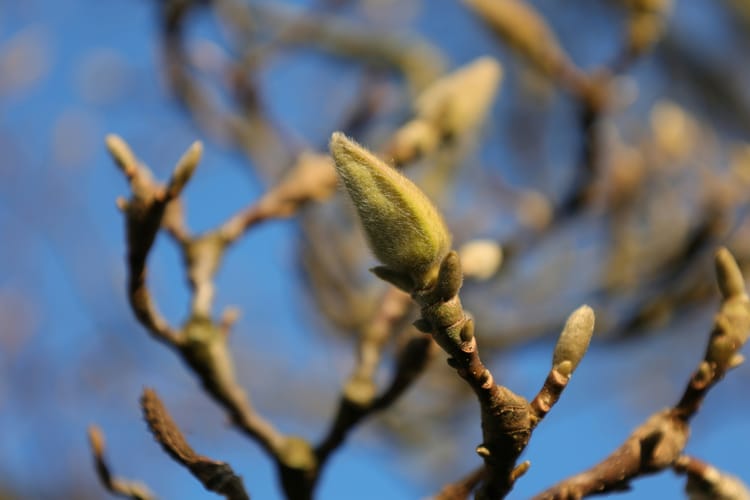
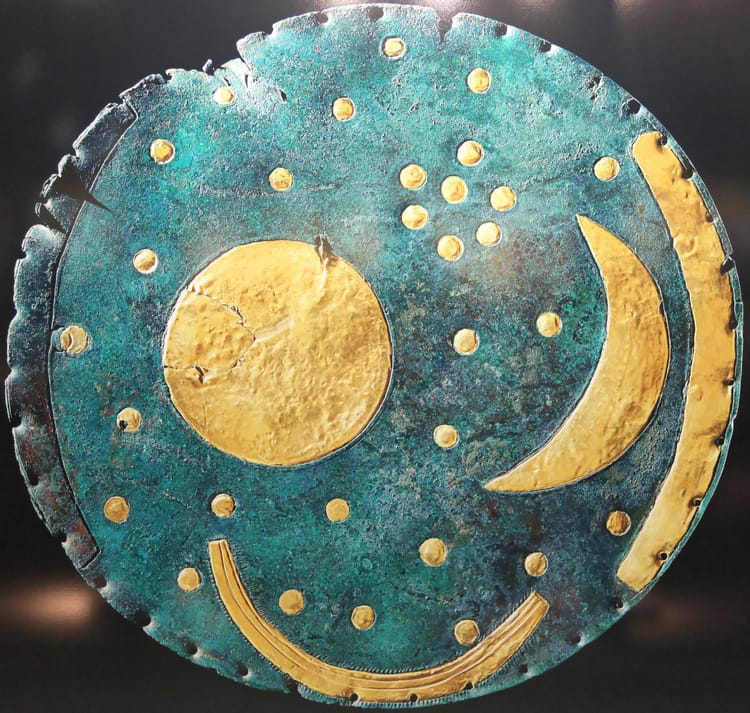
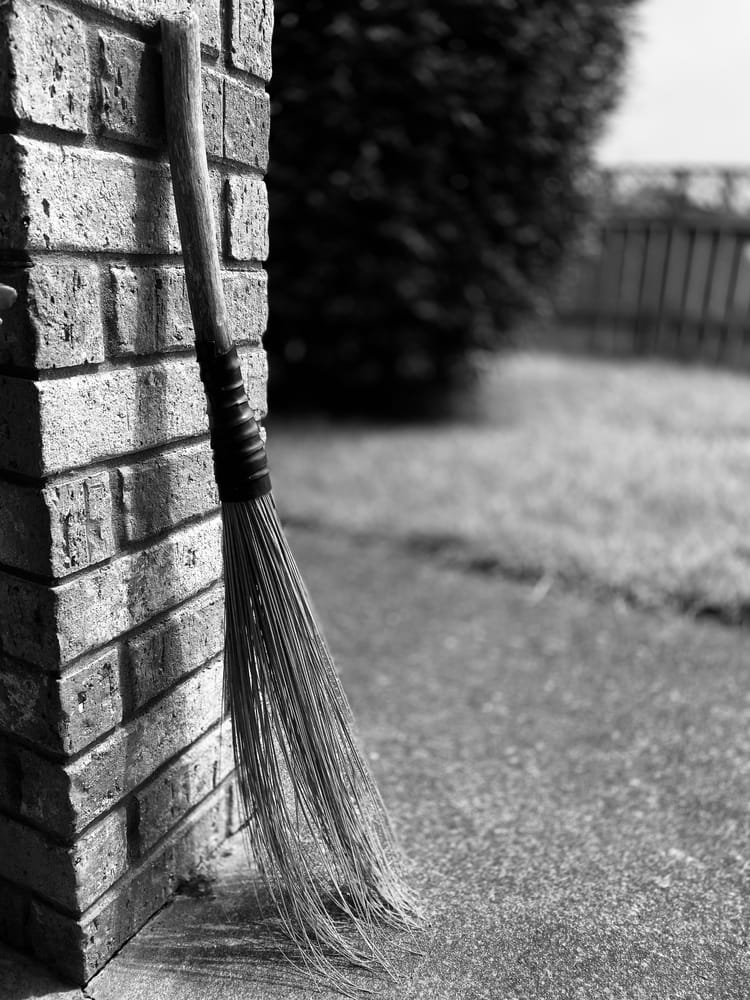

Member discussion